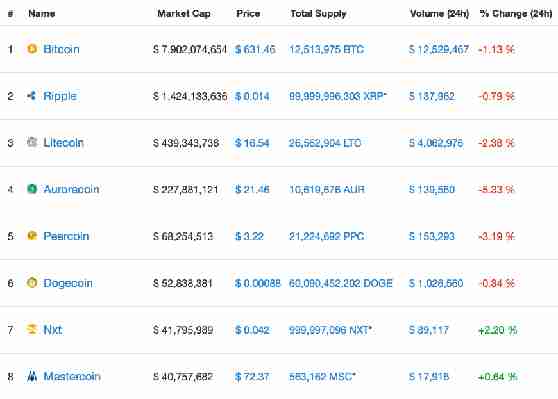Take a deep breathe and close your eyes for a moment. Katy Perry’s new, inspiring smash-hit, “Roar,” is playing on the radio. Open your eyes. Go catch a movie, and more than likely you’ll watch the much-anticipated LEGO Movie.

Then, take a break from churning out Luigi death stare memes to check on your recent cryptocurrency investment. Bitcoin, now just five years old, is worth a whopping $630, and you’re totally confident Auroracoin is the next big thing in blockchain, even though you’re not really from Iceland.
Welcome back to 2014 – the Ethereum crowdsale has just begun , and XRP is still called Ripple ! What a time to be alive.


Back in 2014 ( almost five years ago ), Bitcoin, Ripple and Litecoin were the top three coins on the market, but that’s where the similarities end. Following those still-relevant names was a swathe of forgotten cryptocurrency projects, like Nxt and Mastercoin.
Be honest: do you remember Auroracoin, the Icelandic alternative to Bitcoin that promised each citizen free cryptocurrency through a series of airdrops tied to the national identification system?
In 2014, it was the fourth most popular cryptocurrency in the world, and hit a peak of over $40 in the first quarter of that year. After being labeled a scam as it failed on its lofty quest to replace local currency, it’s now completely irrelevant (despite a chance revival attempt in 2016 ).
Today, it’s valued at just $0.05, and ranked #1249 by market cap.
Peercoin, the Proof-of-Stake cryptocurrency was in the fifth spot. It was once described by the New York Times as Bitcoin’s rival , primarily because it had been accepted at a Star Trek convention, and was supposedly “more green.” At its peak, Peercoins were worth more than $7 each, now they’re worth $0.49.
Not to mention, Peercoin’s market cap is now an infinitesimal fraction of Bitcoin‘s. So pure, NYT.
Mastercoin is probably the most curious platform to disappear from our zeitgeist. It was a layer built on top of Bitcoin (leveraging its timestamps) that businesses could use to launch their own tokens.
It famously raised 4,000 BTC ($500K at the time, $15M today) in 2013 with nothing but a white paper and a vision . A couple of years later, its controversially centralized distribution forced its leaders into rebranding the platform to “Omni.”
Omni is currently the 695th most “popular” cryptocurrency ranked by market cap, with a price of just over $2 (down from over $180 at the start of 2014).
So while it’s certainly still easy to take a glance at today’s ‘top eight’ cryptocurrencies and scoff at some of the more dubious inclusions, take a moment and pour one out for projects that never made it – one day, they might join them.
Kik fires staff and shuts down messaging app but won’t stop fighting the SEC over its ICO
Following an embroiled relationship with the US Securities and Exchange Commission over its cryptocurrency come security token Kin, it appears that messaging app Kik‘s days are numbered.

Kik‘s CEO, Ted Livingston, said in a blog post this morning that the ongoing fight with the SEC has left the company with no other decision but to shut down its messaging app.
“…all is not well,” Livingston said. “This is a direct impact from the [SEC’s] legal action.”
Kik is also reducing its staff of hundreds down to an “elite 19 person team,” – brutal – and says it will now focus on converting Kin users into Kin buyers. Not sure that’ll help its case with the SEC, though.
It seems that Kik is stripping itself back to the bare essentials to continue to fight the SEC‘s claim that its Kin token is a security and not a currency. While Kik is dying, Kin will live on – for now.
What’s more, it was reported that Livingston might also be going the same way as the app. CoinDesk reported that the CEO sent a confusingly misdirected text message in which he allegedly said he was “fed up with this shit,” and that he would quit as CEO. However, according to a recent statement from General Counsel for Kik , Eileen Lyon, this is false and the texts were from an impersonator. Livingston also later Tweeted claiming the texts were false.
Repercussions
The SEC started going after Kik last year after it concluded its initial coin offering was more security than cryptocurrency.
Between May and September 2017 , Kik sold Kin tokens to over 10,000 investors all over the world, raising around $100 million in the process.
According to court documents filed by the SEC, Kik allegedly marketed Kin tokens as an investment and told investors that rising demand would drive up the value of the “cryptocurrency.”
It doesn’t look like Kik is learning from this whole debacle either. Kik‘s decision to focus on increasing sales of Kin may only exacerbate problems if the SEC persists with its assertion that Kin is a security.
Back in May this year, Kik setup the “ Defend Crypto Fund ” to help pay for its legal battle with the SEC. According to the Defend Crypto website, over $1.6 million has been donated to date.
Given the precedent that the SEC‘s decision could set, Kik said the fund was important for the future of the industry and not just its own battle. However, it’s probably unrealistic that the SEC‘s decision will affect true Proof-of-Work cryptocurrencies like Bitcoin.
Kin operates on “decentralized infrastructure run by a dozen independent companies,” Livingston said in the blog post. The SEC‘s decision will likely then stand to affect digital currencies which are delivered by consortia , like Facebook’s Libra.
If you use Kik to, y’know, actually talk to people, this news will surely suck. But don’t worry, there’s plenty of other messaging apps that aren’t embroiled with the SEC.
Come say hi to the Hard Fork team at our blockchain event . On October 15-17 in Amsterdam, hear from top experts as they discuss the industry’s future.
Update, September 24, 1155UTC: Kik has since issued a statement regarding the CoinDesk article cited in the above. The organization has said that Ted Livingston was being impersonated, and the texts are a hoax. The article has been updated to reflect this.
Police bust potential Bitcoin money laundering scheme in Brazil
Brazilian police have arrested a man on suspicion that he was running a drug trafficking ring and laundering funds using Bitcoin.

According to a local report , law enforcement officials found a clandestine drug laboratory containing Bitcoin mining equipment in Porto Alegre, in southern Brazil, and arrested the unnamed man yesterday.
In the flat, located in the city’s southern quarter, police found equipment valued at approximately $63,000 (R$ 250,000). All 25 devices were switched on, according to police, and seemingly functioned 24 hours a day. The equipment was found in a small room with little ventilation.
Local reports say the man claimed to own the equipment, and said he had rented the space to mine Bitcoin as an investment.
He refuted claims about his potential involvement in an organized crime ring, but was accused of stealing after officers realised he was using an illegal electricity connection to power the equipment.
Police suspect this man, w ho was in possession of a gun with an erased serial number and a motorbike with cloned number plates, was a lookout.
The man has a history of trafficking and murder and is known to the authorities, says another report .
“The flat is well-hidden. We are going to investigate further. Everything points to a Bitcoin mining operation. They could be exchanging the money and use it to fuel drug trafficking. There’s also the possibility that they are using the funds derived from drug trafficking to buy Bitcoin,” said Adriano Nonnenmacher, a police officer, in a loosely translated statement.
Police officers seized the equipment based on suspicions it may have been smuggled into the country as most of it was made in China.
Did you know? Hard Fork has its own stage at TNW2019 , our tech conference in Amsterdam. Check it out .











